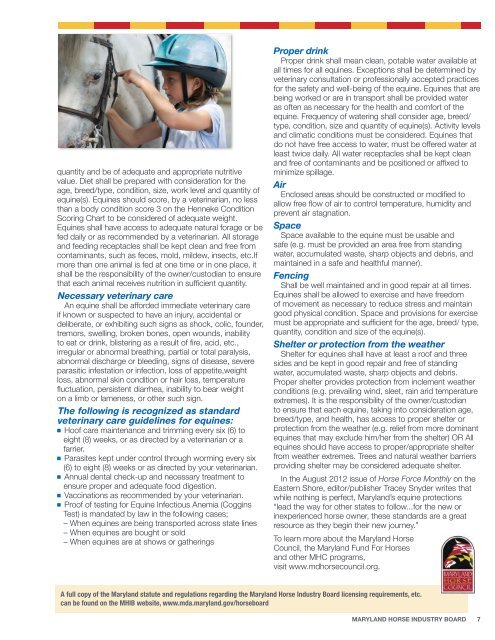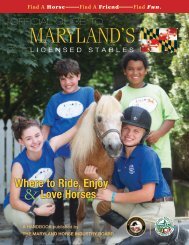MARYLAND’S
MARYLAND’S
MARYLAND’S
Create successful ePaper yourself
Turn your PDF publications into a flip-book with our unique Google optimized e-Paper software.
quantity and be of adequate and appropriate nutritive<br />
value. Diet shall be prepared with consideration for the<br />
age, breed/type, condition, size, work level and quantity of<br />
equine(s). Equines should score, by a veterinarian, no less<br />
than a body condition score 3 on the Henneke Condition<br />
Scoring Chart to be considered of adequate weight.<br />
Equines shall have access to adequate natural forage or be<br />
fed daily or as recommended by a veterinarian. All storage<br />
and feeding receptacles shall be kept clean and free from<br />
contaminants, such as feces, mold, mildew, insects, etc.If<br />
more than one animal is fed at one time or in one place, it<br />
shall be the responsibility of the owner/custodian to ensure<br />
that each animal receives nutrition in sufficient quantity.<br />
Necessary veterinary care<br />
An equine shall be afforded immediate veterinary care<br />
if known or suspected to have an injury, accidental or<br />
deliberate, or exhibiting such signs as shock, colic, founder,<br />
tremors, swelling, broken bones, open wounds, inability<br />
to eat or drink, blistering as a result of fire, acid, etc.,<br />
irregular or abnormal breathing, partial or total paralysis,<br />
abnormal discharge or bleeding, signs of disease, severe<br />
parasitic infestation or infection, loss of appetite,weight<br />
loss, abnormal skin condition or hair loss, temperature<br />
fluctuation, persistent diarrhea, inability to bear weight<br />
on a limb or lameness, or other such sign.<br />
The following is recognized as standard<br />
veterinary care guidelines for equines:<br />
n Hoof care maintenance and trimming every six (6) to<br />
eight (8) weeks, or as directed by a veterinarian or a<br />
farrier.<br />
n Parasites kept under control through worming every six<br />
(6) to eight (8) weeks or as directed by your veterinarian.<br />
n Annual dental check-up and necessary treatment to<br />
ensure proper and adequate food digestion.<br />
n Vaccinations as recommended by your veterinarian.<br />
n Proof of testing for Equine Infectious Anemia (Coggins<br />
Test) is mandated by law in the following cases;<br />
– When equines are being transported across state lines<br />
– When equines are bought or sold<br />
– When equines are at shows or gatherings<br />
Proper drink<br />
Proper drink shall mean clean, potable water available at<br />
all times for all equines. Exceptions shall be determined by<br />
veterinary consultation or professionally accepted practices<br />
for the safety and well-being of the equine. Equines that are<br />
being worked or are in transport shall be provided water<br />
as often as necessary for the health and comfort of the<br />
equine. Frequency of watering shall consider age, breed/<br />
type, condition, size and quantity of equine(s). Activity levels<br />
and climatic conditions must be considered. Equines that<br />
do not have free access to water, must be offered water at<br />
least twice daily. All water receptacles shall be kept clean<br />
and free of contaminants and be positioned or affixed to<br />
minimize spillage.<br />
Air<br />
Enclosed areas should be constructed or modified to<br />
allow free flow of air to control temperature, humidity and<br />
prevent air stagnation.<br />
Space<br />
Space available to the equine must be usable and<br />
safe (e.g. must be provided an area free from standing<br />
water, accumulated waste, sharp objects and debris, and<br />
maintained in a safe and healthful manner).<br />
Fencing<br />
Shall be well maintained and in good repair at all times.<br />
Equines shall be allowed to exercise and have freedom<br />
of movement as necessary to reduce stress and maintain<br />
good physical condition. Space and provisions for exercise<br />
must be appropriate and sufficient for the age, breed/ type,<br />
quantity, condition and size of the equine(s).<br />
Shelter or protection from the weather<br />
Shelter for equines shall have at least a roof and three<br />
sides and be kept in good repair and free of standing<br />
water, accumulated waste, sharp objects and debris.<br />
Proper shelter provides protection from inclement weather<br />
conditions (e.g. prevailing wind, sleet, rain arid temperature<br />
extremes). It is the responsibility of the owner/custodian<br />
to ensure that each equine, taking into consideration age,<br />
breed/type, and health, has access to proper shelter or<br />
protection from the weather (e.g. relief from more dominant<br />
equines that may exclude him/her from the shelter) OR All<br />
equines should have access to proper/appropriate shelter<br />
from weather extremes. Trees and natural weather barriers<br />
providing shelter may be considered adequate shelter.<br />
In the August 2012 issue of Horse Force Monthly on the<br />
Eastern Shore, editor/publisher Tracey Snyder writes that<br />
while nothing is perfect, Maryland’s equine protections<br />
“lead the way for other states to follow...for the new or<br />
inexperienced horse owner, these standards are a great<br />
resource as they begin their new journey.”<br />
To learn more about the Maryland Horse<br />
Council, the Maryland Fund For Horses<br />
and other MHC programs,<br />
visit www.mdhorsecouncil.org.<br />
A full copy of the Maryland statute and regulations regarding the Maryland Horse Industry Board licensing requirements, etc.<br />
can be found on the MHIB website, www.mda.maryland.gov/horseboard<br />
MARYLAND HORSE INDUSTRY BOARD<br />
7



